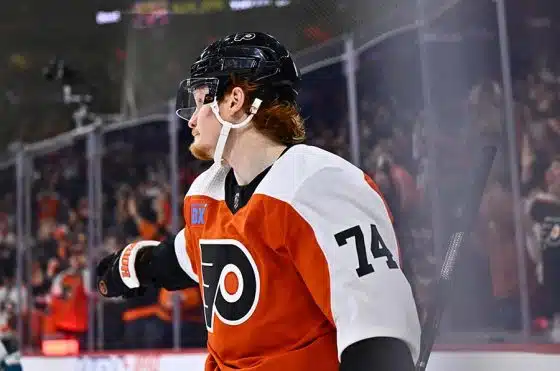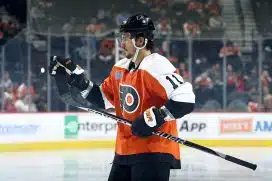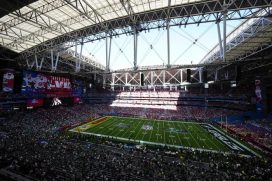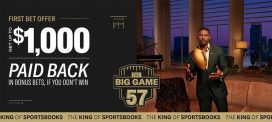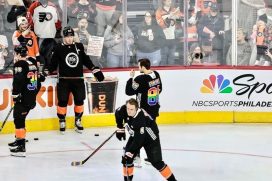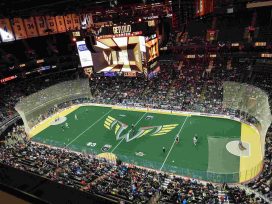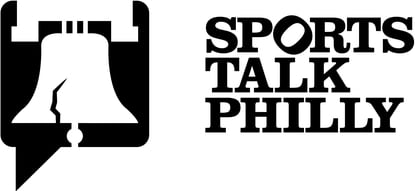Much has been made about Ben Simmons' inability to shoot. But a look at other NBA superstars shows that with work, Simmons should be just fine.
Patrick Causey, on Twitter @pcausey3
(This article originally appeared on seventeenrings.wordpress.com).
Joakim Noah. Karl Anthony-Towns. Hassan Whiteside. Myles Turner. DeAndre Jordan. Ben Simmons.
Each of these players measured at approximately 6'10, 240 lbs leading up to their respective drafts, according to a pre-draft measurement list compiled by DraftExpress.com. But only one of them has the athleticism, handle, passing ability and vision to run the point: Ben Simmons.
It's that rare combination of size and skill that has tantalized scouts, executives and coaches for years, and caused many to consider Simmons a generational talent in the same breath as LeBron James, Anthony Davis and Kevin Durant.
But doubts have started to emerge over whether Simmons remains the top pick in the draft. His inconsistent jumper and sub-par wingspan are legitimate concerns given the league's preference on shooting, floor spacing and length. Questions have also been raised regarding Simmons' drive and leadership after he failed to lead the LSU Tigers to the NCAA tournament. These issues have caused some to gravitate towards Brandon Ingram, the sweet-shooting, gangly small forward that seems like an ideal fit for the modern NBA.
But for as good as Ingram is, I have yet to see a scouting report that suggests he is a better player than Simmons. The reasoning for preferring Ingram instead focuses on the importance of shooting and spacing in today's game; because Simmons provides neither, and Ingram provides both, many conclude that Ingram is the safer pick of the two.
But at the top of the draft, are we really looking for safe? Or are we looking for greatness?
Because for all his faults, Simmons is a special talent. If he can fix his jump shot and become a more consistent dominant force? Watch out. The sky is the limit.
I broke this article down into two parts: first analyzing Simmons' achilles heel — his shooting — to see if it is something with which we should be overly concerned (hint: not likely). Part II breaks down the rest of his game, from his elite size, athleticism, vision, and passing ability.
Shooting
Ben Simmons shot poorly last year.
There is no way to sugarcoat that.
While he shot 56% from the field, Simmons made only 31% of his jump shots, and attempted only three 3 pointers the entire season (making one). Just three!
To make matters worse, Simmons often seemed unwilling to shoot even when he was open.
Teams adjusted, putting smaller, quicker defenders on Simmons and giving him loads of space, daring him to shoot. Simmons never obliged, and his offensive game struggled as a result.
It was around this time that questions started to be asked. If college teams could effectively limit him down the stretch, what will NBA teams — with better athletes, defenders and coaches — be able to do? Can he ever overcome these challenges and become a better shooter? If not, what does that mean for his NBA ceiling?
If Ben Simmons never improves his jumper, his ceiling as a prospect will be limited. There really isn't anyway around that. But whether it is reasonable to expect Simmons to overcome his shooting woes is a question that deserves more attention. To put it bluntly, it is the key question that will determine just how special of a player Simmons becomes.
The single easiest way to identify whether a broken shot can be fixed is to look at the form. Ideally, you want to see the following with every shot:
- The ball on the fingertips of your shooting hand;
- Your shooting arm bent at a 90 degree angle, kept inside your body and in front of your face;
- Your feet shoulder width apart, with your dominant foot slightly ahead of your opposite foot;
- Standing on the balls of your toes;
- Your feet and shoulders are square to the basket;
- Keeping your off-hand to the side, using it as merely a guide up until before the release point;
- Bending your knees, while keeping your torso straight;
- Exploding through your shot in one fluid movement;
- Snapping the wrist of your shooting hand as you extend through your shot;
- Keeping balance throughout, a player should avoid rotating any part of his body — shoulders, feet, hips, etc. — away from the basket.
Now, every player puts their own spin on this. But you want to make sure they don't run too far astray of proper form, and you want to make sure the prospect has good balance and is able to easily replicate his shot. When it comes to deciding whether a prospect can improve as a shooter, I generally use this rule of thumb: small tweaks to a player's form can be overcome, but a complete rebuild from feet to release point can be a daunting task.
For an example close to home, consider Michael Carter-Williams. As Derek Bodner broke down a few years ago, his shot needed a complete rebuild in order to be truly effective. That never happened, and he is now riding the pine behind Antetokounmpo in Milwaukee (so much for that ROY award).
I don't see the same problems with Simmons. When Simmons is on, his form looks smooth, natural, and repeatable. Simmons keeps his feet shoulder width apart, squares his shoulders to the basket, and has a good follow through on his jumper.
This is backed up by Simmons' free throw rate, which was a respectable 67% during his lone season at LSU. (For comparisons sake, Brandon Ingram shot 68% from the charity stripe). Free throw percentage has been a good predictor of whether a player's shot will translate to the NBA, especially at the three point range. Players with good form tend to shoot higher percentage at the line, even if they aren't as consistently productive in less friendly situations (i.e., shooting on the move). So Simmons' free throw rate gives us reason for optimism.
So what are the problems? I see two issues, neither of which occur frequently enough to give me serious pause for concern.
First, Simmons will occasionally place his off-hand to the front of the ball, like this:
This causes a trickle down effect on the rest of his upper body: his elbow cocks out sideways and the ball drifts from the center of his face to opposite of his shooting hand.
For a little contrast and compare, consider Steph Curry's form:
Notice the difference?
The trajectory of the ball is largely determined by the direction that your shooting hand travels. Curiously, we don't see this issue all the time with Simmons. I rarely saw it on spot up jumpers, and cannot recall a single time of seeing him have this problem at the free throw line. Most of the times it happened when Simmons was shooting off the dribble. For a player who hasn't put in the work to perfect his craft, this is the most often time when mechanics go awry. For football fans, think of it as throwing on the run instead of throwing while standing tall in the pocket. The body is moving, so the potential for mechanics to break down becomes magnified.
Simmons also has a habit of letting his front and hips foot drift towards the basket, when he should be keeping his legs/hips square. Watch his left foot on this shot:
As Curry recently explained to CBSSports.com: "You've got to have good balance. A lot of people focus on your hands with your jump shot but it starts with your feet being squared to the basket and having good balance."
Keeping balance and staying square to the basket improve your accuracy. When you shoot off balance and/or start drifting to the side, you are only making it harder on yourself.
The good news for Sixers fans is that both issues are correctable. They are likely the byproduct of an elite prospect who got by on his athleticism and size alone and never had to put in the work to refine his craft. If Simmons took 500-1,000 shots a day this summer just working on fixing these issues (which he should be doing anyway), I would expect to see meaningful improvement next year.
But don't take my word for it. Take Brett Brown's.
Brown coached Kawhi Leonard in San Antonio before accepting the Sixers job in 2013. He also coached Ben Simmons father in Australia, and has known Simmons since he was born. According to Brown, similarities exist between Simmons and Leonard's shot (quote courtesy of LibertyBallers.com):
"I'm sort of very aware of Ben's situation, I lived in Austrailia for a long time. I coached his father for five years, I'm aware of his junior coaches throughout Ben's entire life.
When you look at his form, no differently when we drafted Kawhi Leonard with the Spurs, one of the assessments we had to make is 'Was his shot transferable to the NBA?' Was it a total rebuild or was it a little bit of a makeover? And I think his form isn't one where you just have to blow it up and start over, and I think it can translate."
Coach David Thorpe, the renowned executive director of the Pro Training Center at the IMG Academies in Bradenton, Florida (where he has trained the likes of Joakim Noah, Loul Deng and Kevin Martin, among others), had similar thoughts on Simmons' shot:
"The knock on Simmons as a shooter is somewhat overrated. Let's not forget that another do-it-all type of NBA star was not a good shooter in college. In two seasons, Kawhi Leonard shot 20.5 percent and 29.1 percent from 3, yet is a career 39-percent shooter in the NBA — making 44 percent this season. Simmons has a good-looking stroke, but he never looked as if he was willing to take 3-pointers, and was hesitant to take a lot of jump shots, period. Perhaps this was due to a coaching decision, as he was able to drive by or pass over most defenders. In the NBA, it is fair to expect he will shoot a lot of 3s and be at least good at it, in time."
While it might be a tad ambitious to expect Simmons to improve as significantly as Leonard — as we will see in a moment, Leonard is the extreme outlier when it comes to improved shooting – I am very confident that Simmons can and will improve his shot, assuming he puts in the work.
Why am I so confident? Because it's been done many times before in this league.
Courtesy of Basketball-reference.com, we can break down how often a player shoots from a certain distance from the basket and the shooting percentages for each of those shots. By comparing these statistics during a player's first year with statistics from later in that player's career, we can track how much the player improved with each shot over time.
I went back and looked at four players with whom Simmons is most often compared: LeBron James, Kawhi Leonard, Draymond Green, and Giannis Antetokounmpo (aka the "Greek Freak").
The comparisons are usually made because of similarities in size, athleticism, versatility and the ability to play/defend multiple positions. But the most telling, and arguably least discussed similarity, is that each struggled with their jumper early in their career.
Let's break this down further.
People forget that James was a bad shooter when he first entered the league. During his first two seasons, James shot 35% from shots 3-10 feet away from the rim, and 31% from 10-16 feet during year one. In his second season, he improved only slightly to 37% and 32%, respectively.
% of FGA by Distance FG% by Distance
| Yr | 2P | 0-3 | 3-10 | 10-16 | 16+ | 3P | 2P | 0-3 | 3-10 | 10-16 | 16+ | 3P |
| 03-04 | .855 | .315 | .168 | .161 | .211 | .145 | .438 | .604 | .356 | .313 | .352 | .290 |
| 04-05 | .817 | .311 | .137 | .121 | .248 | .183 | .499 | .725 | .370 | .324 | .373 | .351 |
| 12-13 | .812 | .373 | .133 | .105 | .202 | .188 | .602 | .776 | .494 | .415 | .447 | .406 |
It was not until James reached Miami — after eight years in the league — that he started to become a reliable shooter outside of the paint. Looking at his 2012-13 season (arguably one of the great single seasons of all time), we can see the evolution: James shot 49% from 3-10 feet, 41% from 10-16 feet, and 44% from 16+.
So how did James survive before he developed a consistent shot? By doing the same things that we saw from Simmons during his sole year at LSU: James used his elite athleticism and size to bully his way to the rim, getting himself a high percentage shot or creating open looks for his teammates by forcing the defense to crash and cover his drive. Indeed, only 13% of James' shots came from 3-10 feet during his second year (where he shot 37%), compared to 31% from inside 3 feet (where he shot 72%).
During Kawhi Leonard's two seasons at San Diego State, Leonard shot 20% and 29% from three, respectively. Those issues persisted during his first year in the NBA, where only 35% of Leonard's shots came from 3-10 feet, 10-16, and 16+ feet. And as you see below, that was for good reason: Leonard shot only 39%, 32% and 36% respectively on such shots.
% of FGA by Distance FG% by Distance
| Yr | 2P | 0-3 | 3-10 | 10-16 | 16+ | 3P | 2P | 0-3 | 3-10 | 10-16 | 16+ | 3P |
| 11-12 | .730 | .369 | .176 | .092 | .094 | .270 | .536 | .698 | .394 | .324 | .368 | .376 |
| 15-16 | .733 | .207 | .148 | .201 | .178 | .267 | .528 | .730 | .472 | .498 | .376 | .443 |
Of course, Leonard is now one of the most efficient scorers in the league, thanks in large part to his drastic improvement shooting from anywhere on the court. Just look at his percentages across the different spots on the floor: he shot an absurd 52% from 2 point range and 44% from three this past season. The fact that Brett Brown sees similarities in the shooting technique between Leonard and Simmons is encouraging, to say the least.
Draymond Green is another player that was effective early in his career despite not having a reliable jumper. Green shot an embarrassing 17% (!) from 3-10 feet, 20% from 10-16, 29% from 16+, and 20% from three during his rookie year. But given Green's defensive versatility, he was still a valuable role player for Golden State.
% of FGA by Distance FG% by Distance
| Yr | 2P | 0-3 | 3-10 | 10-16 | 16+ | 3P | 2P | 0-3 | 3-10 | 10-16 | 16+ | 3P |
| 12-13 | .739 | .272 | .132 | .093 | .241 | .261 | .368 | .586 | .176 | .208 | .290 | .209 |
| 15-16 | .685 | .488 | .144 | .023 | .029 | .315 | .537 | .618 | .339 | .368 | .292 | .388 |
What is most encouraging about these numbers is that, with the exception of the three point shot (where Green shot a respectable 38%), Green has only improved slightly everywhere else: shooting 33, 36 and 29% from those same distances. In other words, by just improving his three point shot, Green has transformed himself into a viable threat on offense and is now considered one of the most well rounded players in the league.
Anetokounmpo, or the "Greek Freak" is a 6'11 athletic marvel who some have compared to Simmons. He was, without question, the worst shooter of this group, shooting a combined 20% on shots outside of the paint during his rookie year.
% of FGA by Distance FG% by Distance
| Yr | 2P | 0-3 | 3-10 | 10-16 | 16+ | 3P | 2P | 0-3 | 3-10 | 10-16 | 16+ | 3P |
| 13-14 | .718 | .476 | .098 | .045 | .098 | .282 | .440 | .573 | .171 | .105 | .220 | .347 |
| 15-16 | .892 | .509 | .180 | .058 | .143 | .108 | .537 | .684 | .346 | .288 | .359 | .257 |
The numbers have improved, but he is still by no means a proficient shooter anywhere outside of three feet from the rim. Yet, his career has taken off after Jason Kidd moved Antetokounmpo from small forward to point guard full time in February of last year. During the month of March, the Greek Freak averaged an impressive 19.0 points, 7.3 assists and 7.4 rebounds. All while shooting an embarrassing 30.5% from shots taken outside of 3 feet of the rim.
All of a sudden, Simmons shooting woes are much less pronounced. We have several identifiable examples of players that have established themselves in this league despite struggling early in their career with their jumpers. And given Simmons physical profile and elite athleticism, it says here that he should be able to overcome that limitation early on to still be a valuable contributor.
While the LeBron comparisons are likely unfair, I have no problem using these other three players as comps for Simmons. Whether Simmons becomes a top 3 NBA player (Leonard), a top 15 guy (Green) or a consistent All-Star (Greek Freak) likely depends on how much Simmons improves his jumper. And that likely depends on how much work he puts into fixing his shot.
(Note: Part II will be available later this week, so check back for more)



